Networks and Emotions in Cooperative Work: A Quasi-Experimental Study in University Nursing and Computer Engineering Students
Abstract
1. Introduction
- Analyze the structure of student networks before and after the interdisciplinary intervention.
- Identify the degree of similarity of the students with respect to the emotions perceived in the academic environment.
- Study the relationship of interdisciplinary networks of university students with academic performance.
2. Material and Methods
2.1. Sample Description
2.2. Variables
- Descriptive variables: Sex (male and female) and university degree (Degree in Nursing and Degree in Computer Engineering).
- Network structural variables:
- -
- Centrality. Position in the network: IndegreeN (degree of relationships received by the individual), OutDegreeN (degree of relationships issued), EingvectorN (degree of prestige or influence) and BetweennessN (degree of intermediation) [31].
- -
- Density. Number of relationships present divided by the number of possible relationships [21].
- Emotional variables: Happiness, joy, love, anger, fear and sadness. These were selected based on Bisquerra’s theory of emotions [32], which highlights six main emotions: three positive, namely joy, love and happiness, and three negative, namely fear, anger and sadness.
- Academic performance: Academic evaluation of the results of the cooperative work.
2.3. Instruments Uses to Collect Data
- Degree (Engineering or Nursing).
- Sex.
- To measure the structural variables of centrality, a Likert-type scale from 0 to 4 points was used to assess the sociocentric networks of the entire list of participants in the study. The networks valued were: (a) friendship network: Which of the following partners do you consider to be friends? [33]; and (b) collaboration network: Which of the following colleagues would you ask for help when a problem/doubt/difficulty arises in the academic field? [34].
- When quantifying the emotional variables in the academic environment, two parameters were used: (a) “the intensity with which students consider that the following emotions are present in their academic environment”; and (b) “the intensity with which students consider that the following emotions should be present in their academic environment”. A Likert-type scale was used to answer them, with 0–4 being weighted for the emotions: “happiness”, “love”, “joy”, “anger”, “fear” and “sadness”, with 0 being the “lowest intensity” and 4 the “highest intensity”.
- For the measurement of the academic performance, the final grade obtained in the work was used, scored from 0 to 10. This grade included the individual grades of the written work and the oral presentation.
2.4. Procedure
2.5. Intervention
2.6. Ethical Considerations
2.7. Data Analysis
3. Results
3.1. Descriptive Results on the Sample
3.2. Results of Pre- and Post-Intervention Networks
3.3. Networks and Emotions
3.4. Position of Students in the Network and Emotions (In Cooperative Work)
3.5. Student Network Position and Academic Performance Results (In Cooperative Work)
4. Conclusions
- The interdisciplinary intervention modified the relational pattern of the nursing and computer engineering students, increasing the number of relationships in the collaboration and friendship networks.
- The graphic representation of the pre- and post-intervention networks shows the tendency of the participants to relate to aspects of homophilia based on the university degree.
- The emotions perceived by the students did not show significant changes after the intervention. A direct relationship was found between the students’ centrality and positive emotions and an indirect relationship between centrality and negative emotions.
- There is a significant relationship between OutdegreeN in the collaboration network and academic performance.
- The results show the benefits of introducing interdisciplinary activities in teaching methodologies, so that several technological proposals for healthcare demands were achieved.
Author Contributions
Funding
Acknowledgments
Conflicts of Interest
References
- Grunspan, D.Z.; Wiggins, B.L.; Goodreau, S.M. Understanding classrooms through social network analysis: A primer for social network analysis in education research. CBE Life Sci. Educ. 2014, 13, 167–178. [Google Scholar] [CrossRef] [PubMed]
- Durling, R.; Schick, C. Concept Attainment by Pairs and Individuals as a Function of Vocalization. J. Educ. Psychol. 1976, 68, 83–91. [Google Scholar] [CrossRef]
- Bruun, J.; Brewe, E. Talking and learning physics: Predicting future grades from network measures and Force Concept Inventory pretest scores. Phys. Rev. Spec. Top. Phys. Educ. Res. 2013, 9, 020109. [Google Scholar] [CrossRef]
- Tomás-Miquel, J.V.; Nicolau-Juliá, D.; Expósito-Langa, M. The social relations of university students: Intensity, interaction and association with academic performance/Las relaciones sociales de los estudiantes en la universidad: Intensidad, interrelación y vinculación con el rendimiento académico. Cult. Educ. 2016, 28, 667–701. [Google Scholar] [CrossRef]
- Bruce, K.; Nyland, C. Elton Mayo and the Deification of Human Relations. Organ. Stud. 2011, 32, 383–405. [Google Scholar] [CrossRef]
- Ramos Lugo, G.E.; Triana Gómez, M.L. Escuela de relaciones humanas y su aplicación en una empresa de telecomunicaciones. Scientia Et Technica 2007. [Google Scholar] [CrossRef]
- De la Fuente, J.; Lahortiga-Ramos, F.; Laspra-Solís, C.; Maestro-Martín, C.; Alustiza, I.; Aubá, E.; Martín-Lanas, R. A Structural Equation Model of Achievement Emotions, Coping Strategies and Engagement-Burnout in Undergraduate Students: A Possible Underlying Mechanism in Facets of Perfectionism. Int. J. Environ. Res. Public Health 2020, 17, 2106. [Google Scholar] [CrossRef]
- Hayat, A.A.; Shateri, K.; Amini, M.; Shokrpour, N. Relationships between academic self-efficacy, learning-related emotions, and metacognitive learning strategies with academic performance in medical students: A structural equation model. BMC Med. Educ. 2020, 20, 76. [Google Scholar] [CrossRef] [PubMed]
- Foster, K.N.; McCloughen, A.J. Emotionally intelligent strategies students use to manage challenging interactions with patients and families: A qualitative inquiry. Nurse Educ. Pract. 2020, 43. [Google Scholar] [CrossRef] [PubMed]
- Phan, H.P.; Ngu, B.H.; Lin, R.Y.; Wang, H.W.; Shih, J.H.; Shi, S.Y. Predicting and enhancing students’ positive emotions: An empirical study from a Taiwanese sociocultural context. Heliyon 2019, 5, e02550. [Google Scholar] [CrossRef] [PubMed]
- Olivares, J.; Arrese, F.; Villarreal, M.; Franco, M.; Lozano, A.; Alfageme, V.; Vincet, G.; Damm, N.; Carassay, M. Análisis de emociones referidas por estudiantes universitarios ante distintas estrategias didácticas utilizadas durante su formación profesional. Diálogos Pedagógicos 2019, 17, 83–97. [Google Scholar] [CrossRef]
- Amutio-Kareaga, A.; Justo, C.F.; Linares, J.J.G.; Ma nas, I.M. Aprendizaje y práctica de la conciencia plena en estudiantes de bachillerato para potenciar la relajación y la autoeficacia en el rendimiento escolar. Univ. Psychol. 2015, 14, 433–444. [Google Scholar] [CrossRef]
- Pekrun, R.; Perry, R.P. Control-value theory of achievement emotions. In International Handbook of Emotions in Education; Educational Psychology Handbook Series; Routledge/Taylor & Francis Group: New York, NY, USA, 2014; pp. 120–141. [Google Scholar]
- Oriol-Granado, X.; Mendoza-Lira, M.; Covarrubias-Apablaza, C.G.; Molina-López, V.M. Positive Emotions, Autonomy Support and Academic Performance of University Students: The Mediating Role of Academic Engagement and Self-efficacy. Revista de Psicodidáctica (Engl. ed.) 2017, 22, 45–53. [Google Scholar] [CrossRef]
- Oriol, X.; Amutio, A.; Mendoza, M.; Da Costa, S.; Miranda, R. Emotional Creativity as Predictor of Intrinsic Motivation and Academic Engagement in University Students: The Mediating Role of Positive Emotions. Front. Psychol. 2016, 7, 1243. [Google Scholar] [CrossRef] [PubMed]
- Camilloni, A.R. Docencia, Investigación y Extensión: Un vínculo Necesario; EDUNLPam: La Pampa, Argentine, 2015. [Google Scholar]
- Mellado, V.; Borrachero, A.B.; Brígido, M.; Melo, L.V.; Dávila, M.A.; Ca nada, F.; Conde, M.C.; Costillo, E.; Cubero, J.; Esteban, R.; et al. Emotions in science teaching. Ensenanza de las Ciencias 2014, 32, 11–36. [Google Scholar] [CrossRef]
- D’Mello, S.; Graesser, A. Dynamics of affective states during complex learning. Learn. Instr. 2012, 22, 145–157. [Google Scholar] [CrossRef]
- Tze, V.M.; Daniels, L.M.; Klassen, R.M. Evaluating the Relationship Between Boredom and Academic Outcomes: A Meta-Analysis. Educ. Psychol. Rev. 2016, 28, 119–144. [Google Scholar] [CrossRef]
- Lozares, C. La teoría de redes sociales. Pap. Rev. Sociol. 1996, 48, 103. [Google Scholar] [CrossRef]
- Wasserman, S.; Faust, K. Social Network Analysis: Methods and Applications; Cambridge University Press: Cambridge, UK, 1994. [Google Scholar] [CrossRef]
- López-Roldán, P.; Lozares Colina, C.; Bolíbar Planas, M.; Muntanyola Saura, D. La centralidad en las redes sociales. Metodología de Encuestas 2013, 15, 0077–97. [Google Scholar]
- Baldwin, T.T.; Bedell, M.D.; Johnson, J.L. The social fabric of a team-based M.B.A. program: Network effects on student satisfaction and performance. Acad. Manag. J. 1997, 40, 1369–1397. [Google Scholar] [CrossRef]
- Alahmari, M.D. Interprofessional Education: Saudi Health Students’ Attitudes Toward Shared Learning. Adv. Med Educ. Pract. 2019, 10, 1061–1067. [Google Scholar] [CrossRef] [PubMed]
- Jones, C. Interdisciplinary Approach—Advantages, Disadvantages, and the Future Benefits of Interdisciplinary Studies. ESSAI 2009, 7, 26. [Google Scholar]
- Rhoten, D.; O’Connor, E.; Hackett, E.J. The Act of Collaborative Creation and the Art of Integrative Creativity: Originality, Disciplinarity and Interdisciplinarity. Thesis Elev. 2009, 96, 83–108. [Google Scholar] [CrossRef]
- Rangachari, P.; Dellsperger, K.C.; Rethemeyer, R.K. Network analysis of the structure of inter-professional knowledge exchange related to electronic health record medication reconciliation within a social knowledge networking system. J. Healthc. Leadersh. 2019, 11, 87–100. [Google Scholar] [CrossRef]
- Shifflett, S.D.; Newcomer-Johnson, T.; Yess, T.; Jacobs, S. Interdisciplinary Collaboration on Green Infrastructure for Urban Watershed Management: An Ohio Case Study. Water 2019, 11, 738. [Google Scholar] [CrossRef] [PubMed]
- Ryan, D.; Emond, M.; Lamontagne, M.E. Social network analysis as a metric for the development of an interdisciplinary, inter-organizational research team. J. Interprof. Care 2014, 28, 28–33. [Google Scholar] [CrossRef] [PubMed]
- Kim, H.N. A conceptual framework for interdisciplinary education in engineering and nursing health informatics. Nurse Educ. Today 2019, 74, 91–93. [Google Scholar] [CrossRef]
- Freeman, L.C. Centrality in social networks conceptual clarification. Soc. Netw. 1978, 1, 215–239. [Google Scholar] [CrossRef]
- Bisquerra, R.; Salovey, P.; Mayer, J. Psicopedagogía de las emociones. Síntesis 2009, 9, 185–211. [Google Scholar]
- De Lange, D.; Agneessens, F.; Waege, H. Asking Social Network Questions: A Quality Assessment of Different Measures. Metodološki Zvezk 2004, 1, 351–378. [Google Scholar]
- Ahuja, G. collaboration networks, Structural Holes, and Innovation: A Longitudinal Study. Adm. Sci. Q. 2000, 45, 425–455. [Google Scholar] [CrossRef]
- Borgatti, S.P.; Everett, M.G.; Freeman, L.C. Ucinet for Windows: Software for Social Network Analysis. Harv. Anal. Technol. 2002. [Google Scholar] [CrossRef]
- Benítez, J.A.; Labra, J.E.; Quiroga, E.; Martín, V.; García, I.; Marqués-Sánchez, P.; Benavides, C. A Web-Based Tool for Automatic Data Collection, Curation, and Visualization of Complex Healthcare Survey Studies including Social Network Analysis. Comput. Math. Methods Med. 2017, 2017, 2579848. [Google Scholar] [CrossRef] [PubMed]
- Russell-Minda, E.; Jutai, J.; Speechley, M.; Bradley, K.; Chudyk, A.; Petrella, R. Health technologies for monitoring and managing diabetes: A systematic review. J. Diabetes Sci. Technol. 2009, 3, 1460–1471. [Google Scholar] [CrossRef]
- Li, P.H. 3D Bioprinting Technologies: Patents, Innovation and Access. Law Innov. Technol. 2014, 6, 282–304. [Google Scholar] [CrossRef]
- Smith, A.C.; Thomas, E.; Snoswell, C.L.; Haydon, H.; Mehrotra, A.; Clemensen, J.; Caffery, L.J. Telehealth for global emergencies: Implications for coronavirus disease 2019 (COVID-19). J. Telemed. Telecare 2020. [Google Scholar] [CrossRef]
- Kopera, S.; Wszendybył-Skulska, E.; Cebulak, J.; Grabowski, S. Interdisciplinarity in Tech Startups Development—Case Study of ‘Unistartapp’ Project. Found. Manag. 2018, 10. [Google Scholar] [CrossRef]
- Rafael, V.; José, Q.M. Collaborative Learning and Interdisciplinarity Applied to Teaching Entrepreneurship. Procedia Soc. Behav. Sci. 2013, 93, 1510–1515. [Google Scholar] [CrossRef][Green Version]
- Pawar, S.; Jacques, T.; Deshpande, K.; Pusapati, R.; Meguerdichian, M.J. Evaluation of cognitive load and emotional states during multidisciplinary critical care simulation sessions. BMJ Simul. Technol. Enhanc. Learn. 2018, 4, 87–91. [Google Scholar] [CrossRef]
- Webster, A. Innovative Health Technologies and the Social: Redefining Health, Medicine and the Body. Curr. Sociol. 2002, 50, 443–457. [Google Scholar] [CrossRef]
- Saqr, M.; Fors, U.; Tedre, M.; Nouri, J. How social network analysis can be used to monitor online collaborative learning and guide an informed intervention. PLoS ONE 2018, 13, e0194777. [Google Scholar] [CrossRef]
- Ergün, E.; Usluel, Y.K. An analysis of density and degree-centrality according to the social networking structure formed in an online learning environment. Educ. Technol. Soc. 2016, 19, 34–46. [Google Scholar]
- Liébana-Presa, C.; Andina-Díaz, E.; Reguera-García, M.M.; Fulgueiras-Carril, I.; Bermejo-Martínez, D.; Fernández-Martínez, E. Social Network Analysis and Resilience in University Students: An Approach from Cohesiveness. Int. J. Environ. Res. Public Health 2018, 15, 2119. [Google Scholar] [CrossRef]
- Boda, Z.; Elmer, T.; Vörös, A.; Stadtfeld, C. Short-term and long-term effects of a social network intervention on friendships among university students. Sci. Rep. 2020, 10, 2889. [Google Scholar] [CrossRef]
- Verd, J.M.; Lozares, C.; Cruz, I.; Barranco, O. La homofilia/heterofilia en el marco de la teoría y análisis de redes sociales. Orientación metodológica, medición y aplicaciones. Metodología de Encuestas 2014, 16, 5–25. [Google Scholar]
- Mascia, D.; Di Vincenzo, F.; Iacopino, V.; Fantini, M.P.; Cicchetti, A. Unfolding similarity in interphysician networks: The impact of institutional and professional homophily. BMC Health Serv. Res. 2015, 15. [Google Scholar] [CrossRef] [PubMed]
- Morelli, S.A.; Ong, D.C.; Makati, R.; Jackson, M.O.; Zaki, J. Empathy and well-being correlate with centrality in different social networks. Proc. Natl. Acad. Sci. USA 2017, 114, 9843–9847. [Google Scholar] [CrossRef] [PubMed]
- Por, J.; Barriball, L.; Fitzpatrick, J.; Roberts, J. Emotional intelligence: Its relationship to stress, coping, well-being and professional performance in nursing students. Nurse Educ. Today 2011, 31, 855–860. [Google Scholar] [CrossRef]
- Naseem, S.; Munaf, S. Suicidal Ideation, Depression, Anxiety, Stress, And Life Satisfaction Of Medical, Engineering, And Social Sciences Students. J. Ayub Med. Coll. Abbottabad JAMC 2017, 29, 422–427. [Google Scholar]
- Mohr, S.; Grahn, H.; Krohne, C.; Brätz, J.; Guse, A.H. Academic emotions during an interprofessional learning episode in a clinical context: Assessing within- and between-variation. J. Interprofessional Care 2020. [Google Scholar] [CrossRef]
- Riemer, M.J. Integrating emotional intelligence into engineering education. World Trans. Eng. Technol. Educ. 2003, 2, 189–194. [Google Scholar]
- Requena Santos, F. Género, redes de amistad y rendimiento académico. Pap. Rev. Sociol. 1998, 56, 233. [Google Scholar] [CrossRef]
- van Rijsewijk, L.G.M.; Oldenburg, B.; Snijders, T.A.B.; Dijkstra, J.K.; Veenstra, R. A description of classroom help networks, individual network position, and their associations with academic achievement. PLoS ONE 2018, 13, e0208173. [Google Scholar] [CrossRef] [PubMed]
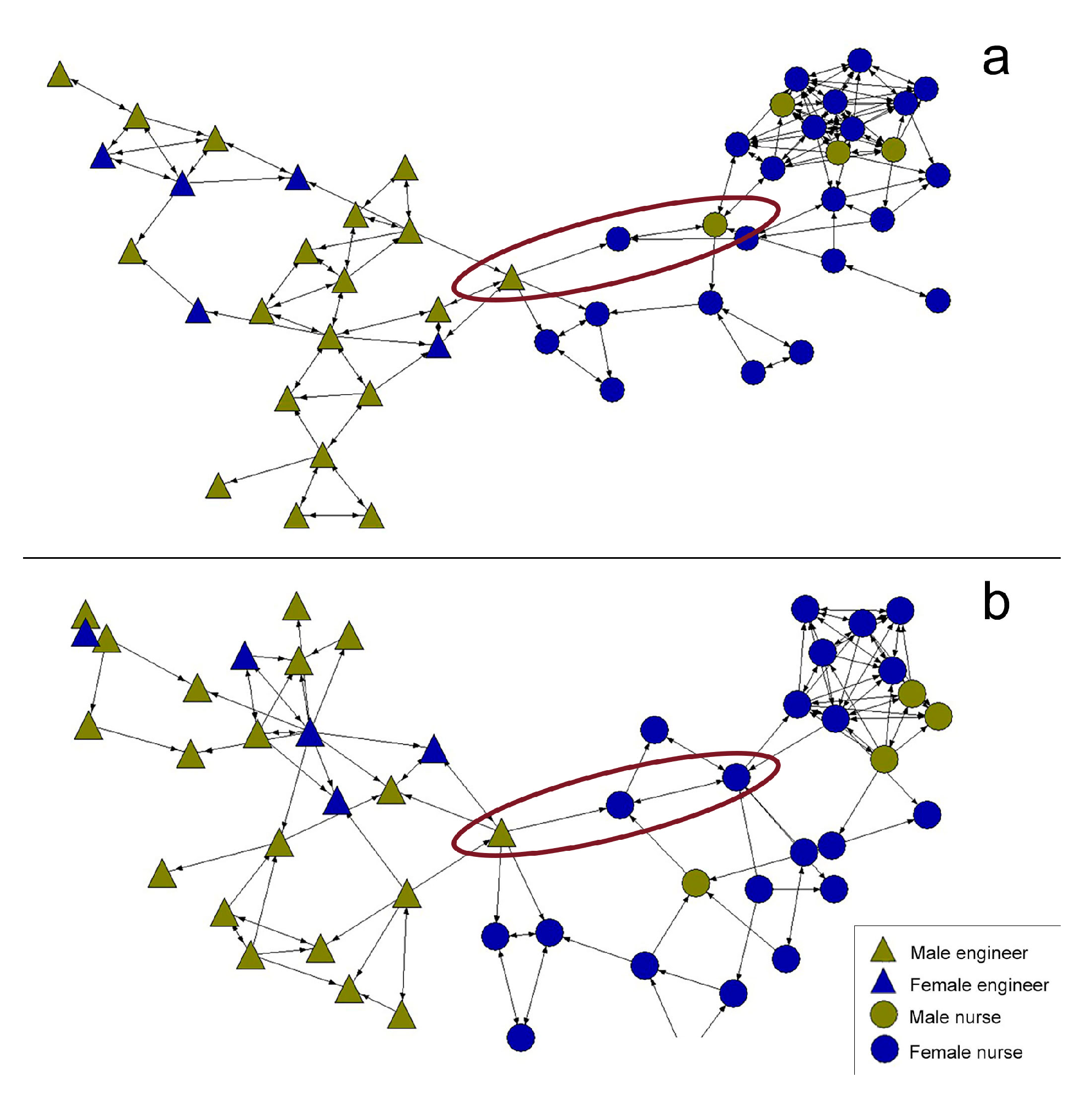
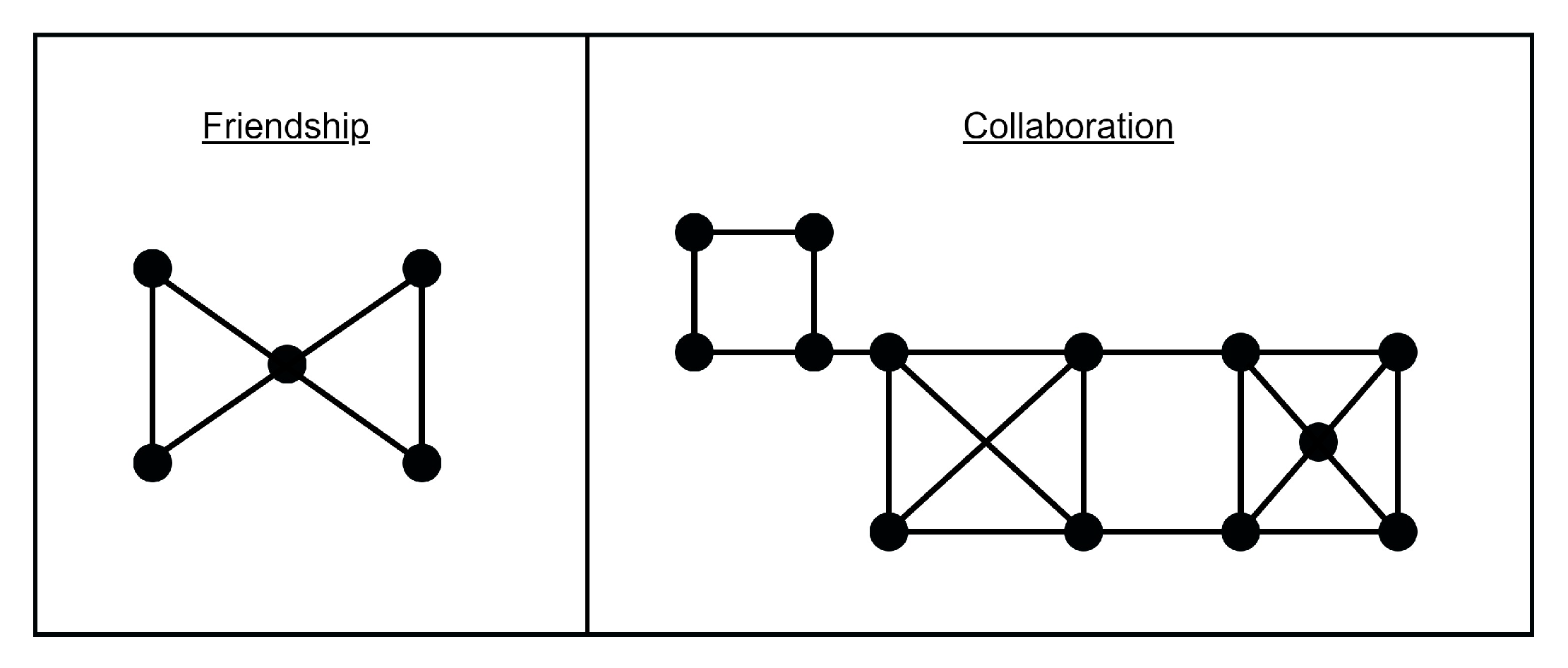
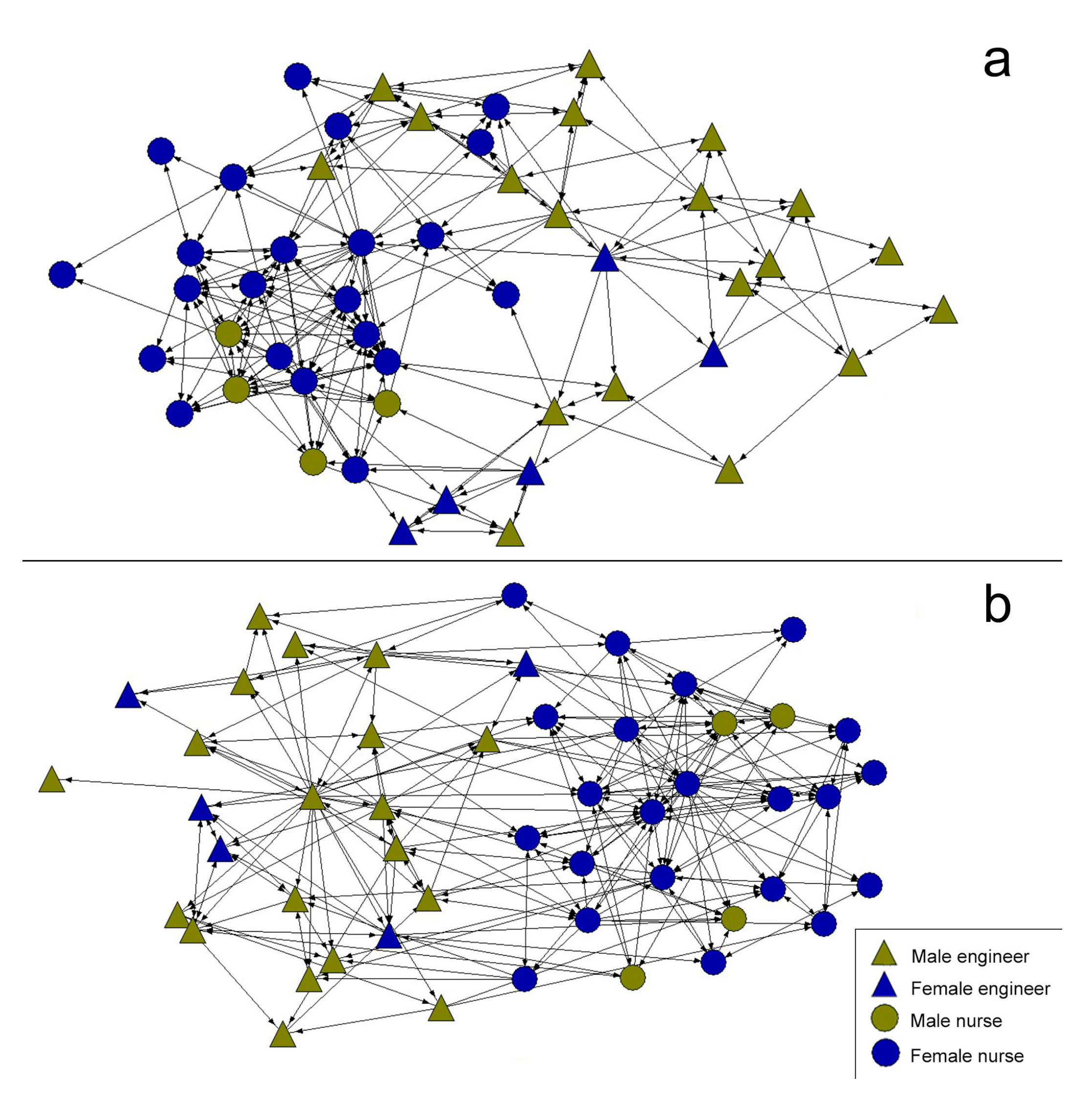
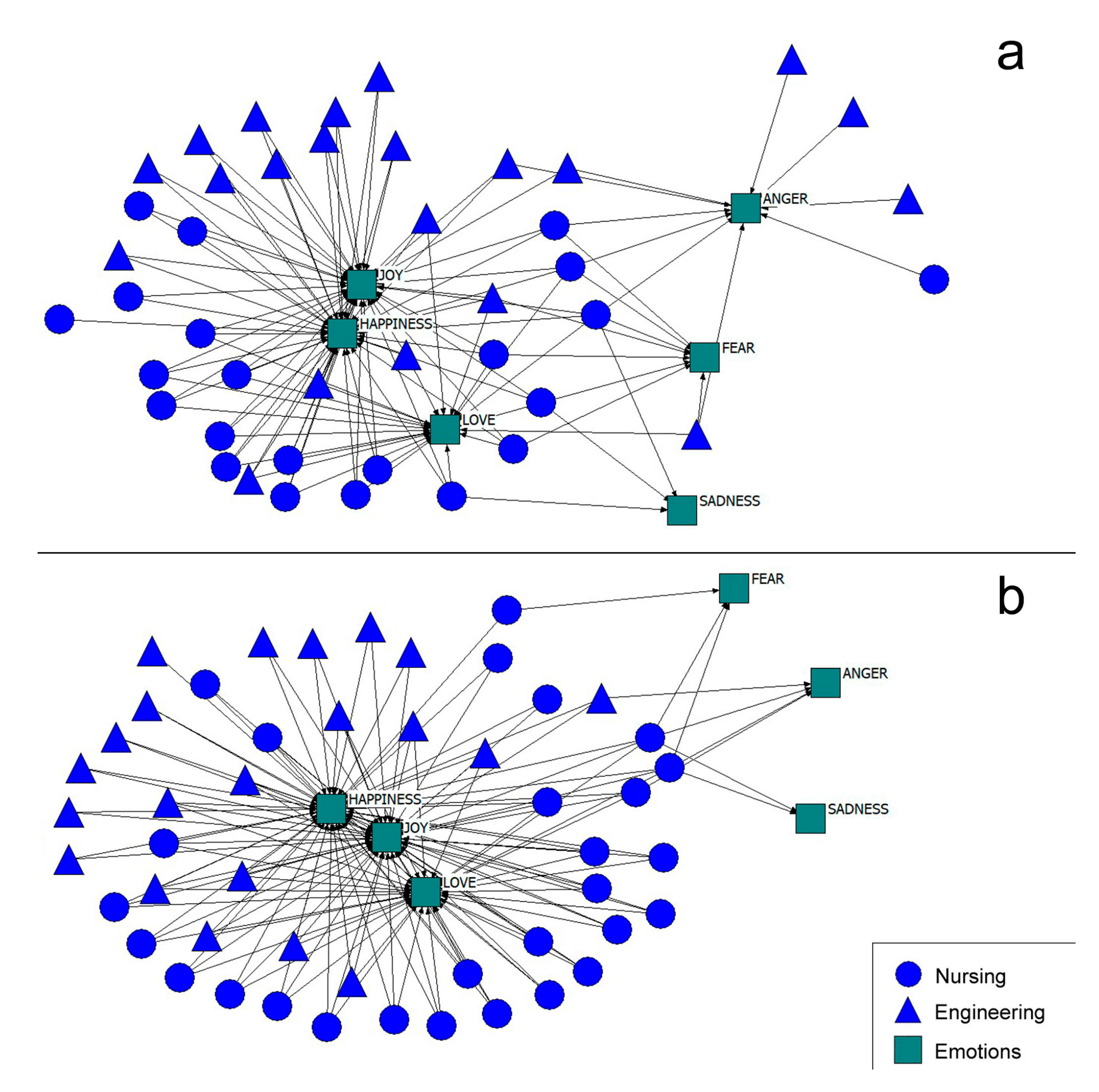
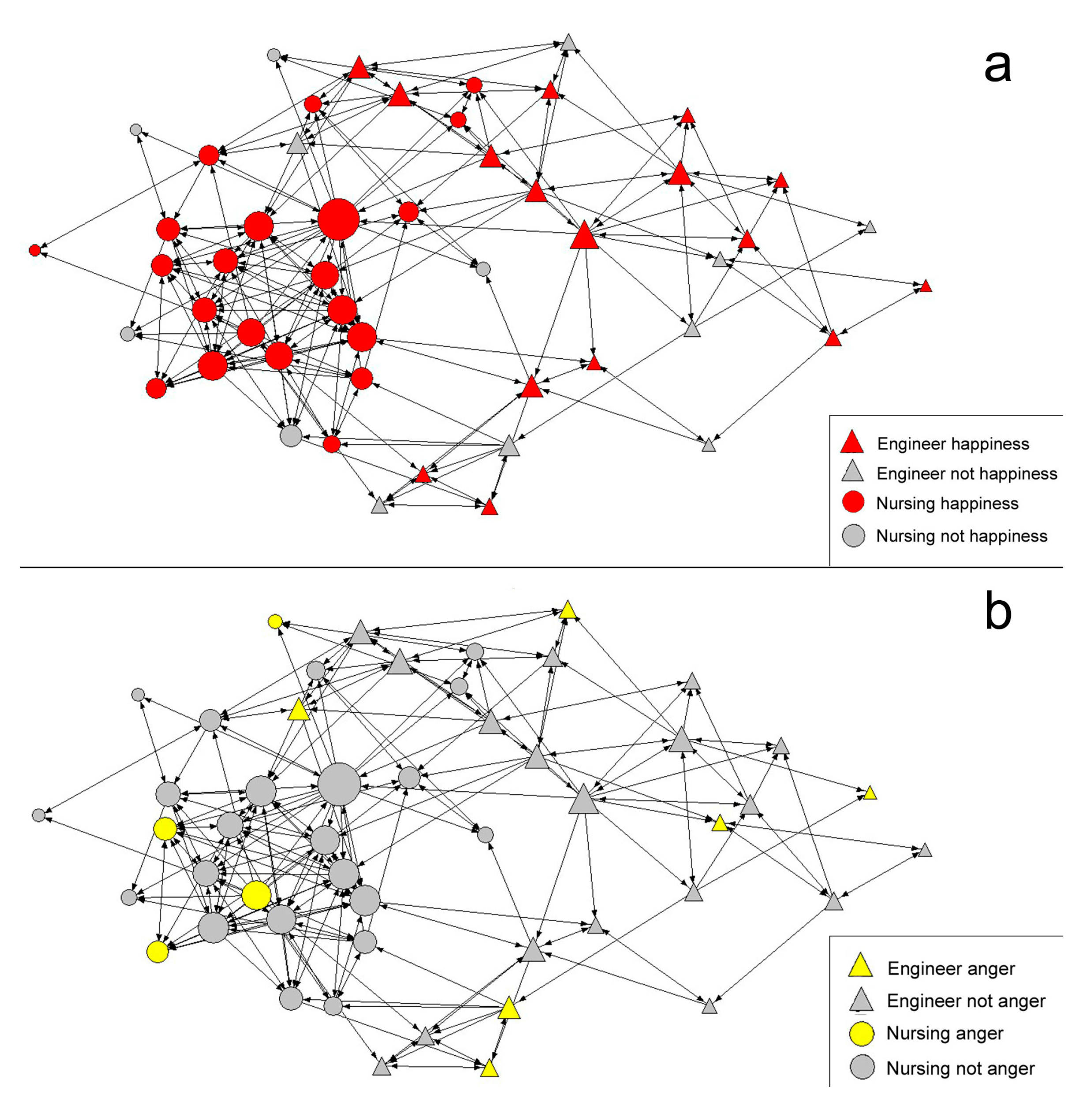
| Degree | Sex | TOTAL | |||
|---|---|---|---|---|---|
| Men | Women | ||||
| N | % | N | % | ||
| Nursing | 4 | 15.4 | 22 | 84.6 | 26 |
| Computer engineering | 19 | 79.2 | 5 | 22.08 | 24 |
| TOTAL | 23 | 27 | 50 | ||
| Network | Centrality Variable | Values |
|---|---|---|
| Collaboration | Without support | 0, 1, 2 |
| With support | 3, 4 | |
| Friendship | Whithout frienship | 0, 1, 2 |
| With friendship | 3, 4 |
| Pre-Intervention | Post-Intervention | ||
|---|---|---|---|
| Friendship | Collaboration | Friendship | Collaboration |
| 0.074 | 0.053 | 0.105 | 0.107 |
| Present Emotions | |||||||||||
|---|---|---|---|---|---|---|---|---|---|---|---|
| Happiness | Love | Joy | Anger | Fear | Sadness | ||||||
| Nur. | Eng. | Nur. | Eng. | Nur. | Eng. | Nur. | Eng. | Nur. | Eng. | Nur. | Eng. |
| 61.5% | 75% | 31% | 12.5% | 61.5% | 62.5% | 27% | 20.1% | 27% | 4.2% | 3.9% | 8.3% |
| Emotions That Should Be Present | |||||||||||
| Happiness | Love | Joy | Anger | Fear | Sadness | ||||||
| Nur. | Eng. | Nur. | Eng. | Nur. | Eng. | Nur. | Eng. | Nur. | Eng. | Nur. | Eng. |
| 100% | 91.7% | 88.5% | 45.8% | 100% | 95.8% | 3.8% | 4.2% | 7.7% | 0 | 3.8% | 0 |
| Present Emotions | |||||||||||
|---|---|---|---|---|---|---|---|---|---|---|---|
| Happiness | Love | Joy | Anger | Fear | Sadness | ||||||
| Nur. | Eng. | Nur. | Eng. | Nur. | Eng. | Nur. | Eng. | Nur. | Eng. | Nur. | Eng. |
| 80.8% | 66.7% | 61.5% | 25% | 77% | 70.8% | 15.4% | 25% | 23.1% | 8.3% | 11.5% | 0 |
| Emotions That Should Be Present | |||||||||||
| Happiness | Love | Joy | Anger | Fear | Sadness | ||||||
| Nur. | Eng. | Nur. | Eng. | Nur. | Eng. | Nur. | Eng. | Nur. | Eng. | Nur. | Eng. |
| 96.2% | 100% | 84.6% | 50% | 92.3% | 95.8% | 11.5% | 4.2% | 11.5 | 0 | 7.7% | 0 |
© 2020 by the authors. Licensee MDPI, Basel, Switzerland. This article is an open access article distributed under the terms and conditions of the Creative Commons Attribution (CC BY) license (http://creativecommons.org/licenses/by/4.0/).
Share and Cite
Marqués-Sánchez, P.; García-Rodríguez, I.; Benítez-Andrades, J.A.; Fulgueiras-Carril, I.; Fernández-Sierra, P.; Fernández-Martínez, E. Networks and Emotions in Cooperative Work: A Quasi-Experimental Study in University Nursing and Computer Engineering Students. Healthcare 2020, 8, 220. https://doi.org/10.3390/healthcare8030220
Marqués-Sánchez P, García-Rodríguez I, Benítez-Andrades JA, Fulgueiras-Carril I, Fernández-Sierra P, Fernández-Martínez E. Networks and Emotions in Cooperative Work: A Quasi-Experimental Study in University Nursing and Computer Engineering Students. Healthcare. 2020; 8(3):220. https://doi.org/10.3390/healthcare8030220
Chicago/Turabian StyleMarqués-Sánchez, Pilar, Isaías García-Rodríguez, José Alberto Benítez-Andrades, Iván Fulgueiras-Carril, Patricia Fernández-Sierra, and Elena Fernández-Martínez. 2020. "Networks and Emotions in Cooperative Work: A Quasi-Experimental Study in University Nursing and Computer Engineering Students" Healthcare 8, no. 3: 220. https://doi.org/10.3390/healthcare8030220
APA StyleMarqués-Sánchez, P., García-Rodríguez, I., Benítez-Andrades, J. A., Fulgueiras-Carril, I., Fernández-Sierra, P., & Fernández-Martínez, E. (2020). Networks and Emotions in Cooperative Work: A Quasi-Experimental Study in University Nursing and Computer Engineering Students. Healthcare, 8(3), 220. https://doi.org/10.3390/healthcare8030220








